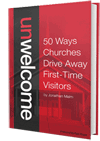So someone has driven by your primary sign, been intrigued and impressed, and they’re coming to your church. What do you tell them now?
Once you have people actually on your campus, your next job is to keep them there. What we’ll call “secondary signs” do that. Signs that show people where to park, how to get in the building, whether or not you have a shuttle and/or multiple buildings, where they can take their children, what events are going on, maybe a sermon series that’s coming up… you know, the nuts and bolts of what you actually do.
Some churches are larger than others so the needs here can vary dramatically. Some churches with sprawling campuses have much more acute needs. Other churches might be chucking and wonder where they’d even put a secondary sign. But whatever your situation, there are ways that secondary signs can help.
Here are a couple things to keep in mind when creating and placing your secondary signs:
- They can be more flexible. Where your primary sign is meant to endure, secondary signs can be less permanent. If you’ve got an event coming up in the fall, a banner announcing it might only need to last a month or two. You still want it to be durable (think vinyl or something comparable, strong enough to survive a decent storm), but it doesn’t have to be immoveable. This usually means less expensive, but also maybe some physical labor to put it up.
- They can be creative. While your primary sign might be fairly static and uniform in appearance, your secondary signs can play with fonts, colors, graphics and language. Sermon titles, this year’s Vacation Bible School, the newest ministry you’re starting, etc., might be begging for a more exciting presentation. Could you announce your shuttle via “Shuttle Express”—an actual station with bright colors and a fun bus for kids—versus just posting “Shuttle” with an arrow pointing to it?
- They can be people! What’s easier and more fun to follow? A metal square on a pole advertising “Visitor Parking,” or a friendly guy/girl wearing a smile and bright orange traffic vest, directing you to a surefire place to park? People are the picture of what goes on in the life of your church.
- They can be electronic. Clearly we’re no strangers to screens these days. Using electronic signs, though expensive, can minimize work and maximize impact. Just type in what you want to advertise, and presto! Instant attraction.
- They can be simple. Sometimes something simple like paper bags with candles can set the right ambiance. Or you could do something fun like small sticks with short phrases, Burma-Shave style. Or set the kids loose with sidewalk chalk.
- Use your surroundings. If you’ve got tall light poles in your parking lot, consider running some vertical banners down the poles that announce events or a sermon series. If there’s a primary walkway to your main entrance, you could use signs along the way to address common questions or promote events. You could use a sign at the exit to offer a benediction as people leave.
- Size, visibility, and clarity still matter. Same as with your primary sign, you want to minimize confusion. This means you want your secondary signs to be big-but-not-too-big, use clear, easy-to-read fonts, and be in places where people will actually see them. You also want to provide only the most important and necessary information. Do you want to note the time for an event or send them to your website? Are you providing direction or inspiration? In essence, what do you want people to know before they walk in your doors?
Your church’s secondary signs can be a fun expression of your congregation’s every day life and the ways God is at work in it. How can you show yourself off?
 More:
More:
- Learn more about how to welcome church visitors with this massive collection of resources and blog posts.
- Walking into a church for the first time can be scary. Check out Unwelcome: 50 Ways Churches Drive Away First-Time Visitors by Jonathan Malm for practical ideas and perspective on first-time guests.




